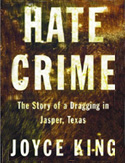Reading Room
Color It Black And White

Two heart-rocking new books—about a vicious Texas murder and a little church that could—paint blistering portraits of race in America.
When her boss at a CBS radio affiliate in Dallas told reporter Joyce King he was sending her to Jasper, the East Texas town where a black man named James Byrd Jr. had been dragged to his death behind a truck, she had a gut reaction: don't go there! Though King, who is black, was a force for change in her racially polarized community, her own painful brushes with bigotry left her with no desire to cover the trials of the three white men accused of Byrd's murder. She wondered if she could be objective, but she took on the assignment. Hate Crime: The Story of a Dragging in Jasper, Texas (Pantheon) is a gripping account of an unimaginably brutal murder. It is also a lesson in how to look racism straight in the eye and not blink.Visiting the "three miles of pain" where the victim struggled to free himself as his body, bound by a log chain, smashed against rocks and asphalt on a deserted country road; viewing police photographs of Byrd's dismembered body; watching the smug expression on the face of his torturer—all made the reporter literally sick. King threw up daily during the trials, and her hair began falling out. She was plagued with nightmares. Still, she tried valiantly to look into the hearts of Byrd's assailants. She became friendly with Jasper's sheriff, a just soul, and other lawmen she would have automatically avoided as a girl growing up in the Deep South. She learned about prison hate groups in a facility called Beto 1, where two of the young men were held before the crime—one of many "racial hotbeds" that, King insists, spawn the violence they are meant to curb. She doesn't see an end to racism in America, but she is keeping her eyes wide open, like her mind.
If a change is coming, it is happening slowly, at places like St. John Baptist Church in Dixiana, South Carolina. After the black church had been repeatedly torched and vandalized, a parishioner, Barbara Simmons, and her white friend Ammie Murray launched a rebuilding campaign that fired the imaginations—and loosened the purse strings—of people around the world. Death threats terrified the two women, but they shared their strengths ("We season each other, just like salt and pepper," Barbara would quip to Ammie), and their example united a shaken community. Standing on Holy Ground: A Triumph over Hate Crime in the Deep South (St. Martin's), by Sandra E. Johnson, shows how faith, love and sheer bullheadedness may lose battle after battle against racism—and still win the war.



